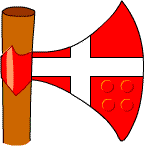World Cup 2002



As you are probably all aware the world Cup is right around the corner and I am here to keep you updated with the latest News and Results.
If you feel that you have something to ask or a problem that you need solving feel free to ask and I will try my Best to answer you?? I will also give you a Simple Layout of all the fixtures with dates and times, Also a bit of background to the venues....
THE VENUES
SOUTH KOREA
SEQUL
- Capacity: 63,961
- Location: 515 Seongsan-dong, Mapo-gu, Seoul
- The Venue: Holders France will kick off the tournament here on 31 May. The rectangular shape of the stands reflects the shape of a traditional Korean kite and also the traditional Korean sailboats.
INCHEON MUNHAK
- Capacity: 52,179
- Location: San 8 Munhak-dong, Nam-gu, Incheon
- The Venue: The second largest port in Korea, Incheon likes to describe itself as the nautical gateway to the capital Seoul. With a new international airport completed in 2001 along with the World Cup stadium.
SUWON
- Capacity: 43,188
- Location: 228 Uman-dong, Paldal-gu, Suwon-si, Gyeonggi-do
- The Venue: Suwon's World Cup venue will include an auxiliary stadium and two practice fields alongside the main arena. Swimming pools, tennis courts, cinemas and concert halls complete the complex.
DAEJEON
- Capacity: 40,407
- Location: 270 Noeun-dong, Yuseong-gu, Daejeon
- The Venue: Known as "Korea's Silicon Valley", Daejeon is a city of technology and administration. The stadium features a semi-closed roof.
JEONJU
- Capacity: 42,391
- Location: 763-1 Banwol-dong, Deokjin-gu, Jeonju-si, Jeollabuk-do
- The Venue: The architects of this stadium like to think it is the most beautiful of the Korean venues. Cables suspended from the roof represent the 12 strings of a Gaya Harp - a local Korean musical instrument.
GWANGJU
- Capacity: 42,880
- Location: 423-2, Pungam-dong, Seo-gu, Gwangju
- The Venue: Gwangju prides itself on being a city of culture and the World Cup matches there will be staged alongside the fourth annual Biennale, an arts festival. The new football-only stadium constructed for the tournament reflects the artistic nature of the area, with its distinctive oval-shaped stands.
- Capacity: 68,014
- Location: 504 Naehwan-dong, Suseong-gu, Daegu
- The Venue: Two matches in the 2001 Fifa Confederations Cup allowed the stadium to show off its Teflon roof - which reflects the curves of a traditional thatched Korean house. That event also demonstrated the environmental nature of Daegu, when the local fans collected their own litter to take home after the games.
DAEGU
ULSAN MUNSU
- Capacity: 43,550
- Location: San 5, Ok-dong, Nam-gu, Ulsan
- The Venue: One of the venues for the Fifa Confederations Cup, this beautiful stadium nestles between the forests of Mount Munsu and Mount Namam. The design is meant to resemble a crane - the bird which is the symbol of Ulsan - in crouching position ready for flight.
BUSAN ASIAN
- Capacity: 55,982
- Location: 1300 Geoje-dong, Yeonje-gu, Busan
- The Venue: South Korea's second largest metropolis uses its coastal position to attract tourists but it is also a sporting city. After the World Cup, the 14th Asian Games will be held here. Work began on this stadium in 1991 and it stands four stories above ground.
JEJU
- Capacity: 42,256
- Location: 914 Beophwan-dong, Seogwipo-si, Jeju-do
- The Venue: A beautiful island with year-round high or warm temperatures, Seogwipo has created a stadium at Jeju-do to match the local landscape. The futuristic design is complemented by a water park and market place as well as plenty of restaurants. Not many teams and fans will complain about having to visit this location.
THE GROUPS
| Group A | Group B | Group C | Group D | |||
|---|---|---|---|---|---|---|
| France | Spain | Brazil | South Korea | |||
| Senegal | Slovenia | China | Poland | |||
| Uruguay | Paraguay | Costa Rica | USA | |||
| Denmark | South Africa | South Korea | Portugal | |||
| Group E | Group F | Group G | Group H | |||
| Geramny | Argentina | Italy | Japan | |||
| Saudi Arabia | Nigeria | Ecuador | Belgium | |||
| Republic Of Ireland | ENGLAND | Croatia | Russia | |||
| Cameroon | Sweden | Mexico | Tunisia |
The Matches
Venues Cont.....
Japan
SAPPORO DOME
- Capacity: 42,000
- Location: 1-3 Hitsujigaoka, Toyohira-ku, Sapporo City
- The Venue: The local climate - which helped attract the Winter Olympics in 1972 - meant an all-weather stadium was essential. The seating system moves aside to allow it in and then slides back into place. The process takes about two hours.
MIYAGI STADIUM
- Capacity: 49,000
- Location: 40-1 Aza-Tate, Sugaya, Rifu-cho, Miyagi
- The Venue: The stadium's crescent-shaped roof is intended to replicate the battle helmet of the powerful Date clan who ruled Miyagi during Japan's feudal period.
NIGATA STADIUM BIG SWAN
- Capacity: 42,300
- Location: 68, Seigoro, Niigata-city, Niigata
- The Venue: Formerly one of Japan's least accessible cities because of its surrounding mountains, Niigata will host the first World Cup finals match to be played in Japan. The stadium's name comes from the translucent white Teflon roof.
IBARAKI PREFECTURAL KASHIMA SOCCER STADIUM
- Capacity: 42,000
- Location: 26-2 Ushiroyama, Jinkoji, Kashima City, Ibaraki
- The Venue: Visitors to the stadium will be met at the entrance by a statue of Brazilian great Zico. He played for and coached the Kashima Antlers, taking them to the J-League championship.
SAITAMA STADIUM 2002
- Capacity: 63,000
- Location: Urawa-shi / Saitama-Ken
- The Venue: Urawa, the capital of the Saitama prefecture on the northern edge of Greater Tokyo, boasts two J-League teams. The Saitama Stadium will be used for one of the semi-finals, plus Japan's first group game. The stadium developers claim to have created "state-of-the-art acoustics and lighting".
INTERNATIONAL STADIUM YOKOHAMA
- Capacity: 70,000
- Location: 3302-5 Kozukue, Kohoku-ku, Yokohama city
- The Venue: The venue for the final, the International Stadium boasts the first two-tiered stand in Japan and remains the biggest venue in the country. Three-quarters of the seats are covered by a stainless steel panel roof and there are giant screens at both ends of the stadium.
SHIZUOKA STADIUM ECOPA
- Capacity: 50,600
- Location: Ogasayama Sports Park, Aino, Fukuroi city
- The Venue: The prefecture of Shizuoka is famous for Mount Fuji, green tea and now football. One of its two J-League teams - Jubilo Iwata - have been crowned Asian champions. This new out-of-town stadium has 5,000 retractable seats which will cover the athletics track around the pitch.
NAGAI STADIUM
- Capacity: 50,000
- Location: 1-1 Nagai Koen, Osaka City
- The Venue: Osaka is known as a city of commerce but it has ambitions to be a major sports city too - hence its (unsuccessful) bid to host the 2008 Olympics, of which Nagai Stadium was an integral part. The stadium is situated within the huge Nagai Park and is five stories high.
KOBE WING STADIUM
- Capacity: 42,000
- Location: 1 Misaki-cho, Hyogo-ku, Kobe City
- The Venue: Kobe dubbed itself an "international sport city" after the student Olympics were held there in 1985. A decade later sport was used as a focus for Kobe's restoration after a major earthquake.
OITA STADIUM BIG EYE
- Capacity: 43,000
- Location: Yokoo, Matsuoka, Oita City, Oita
- The Venue: The name of this impressive domed stadium is explained by the retractable roof which, when being opened and closed, represents a giant winking eye. This makes football viable in any weather.
THE TEAMS
CONVERSATIONS
Latest Messages
| Messages left for this Researcher | Posted |
|---|---|
| Cool page! | Jun 2, 2002 |
| 42 | May 30, 2002 |
| Welcome Grand Master | May 21, 2002 |
| :-) | May 17, 2002 |
| groups e f g h | May 15, 2002 |
Conversations
| Conversation Title | Latest Post | Latest Reply |
|---|---|---|
| World Cup Fever | Jun 26, 2002 | Jul 27, 2002 |
| 42 | May 30, 2002 | May 30, 2002 |
| Welcome Grand Master | May 17, 2002 | May 21, 2002 |
| I am trying | May 21, 2002 | No Replies |
| New and Improved | May 17, 2002 | May 20, 2002 |
The Grand Master
Researcher U194383
Entries
Most Recent Edited Entries
- This user has not written any Edited Entries.
Entries
- This user has not written any Edited Entries.
Disclaimer
h2g2 is created by h2g2's users, who are members of the public. The views expressed are theirs and unless specifically stated are not those of Not Panicking Ltd. If you consider any Entry to be in breach of the site's House Rules, please register a complaint. For any other comments, please visit the Feedback page.
Write an Entry
"The Hitchhiker's Guide to the Galaxy is a wholly remarkable book. It has been compiled and recompiled many times and under many different editorships. It contains contributions from countless numbers of travellers and researchers."